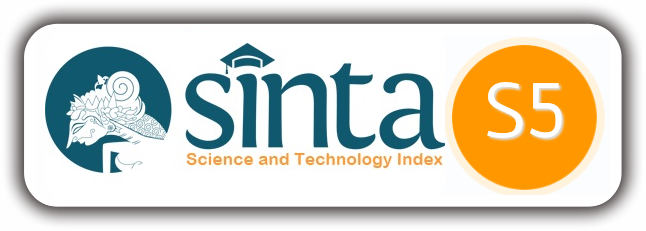ANALISIS PENERIMAAN E-FILING PADA WAJIB PAJAK
Yosef Ervin Riadi Oedi Tjahjadi(1*)
(1) Maksi FEB UGM
(*) Corresponding Author
Abstract
penggunaan persepsian dan kegunaan persepsian mempunyai pengaruh positif dan signifikan terhadap sikap dalam menggunakan e-filing. Sama dengan penelitian sebelumnya, bahwa faktor sikap, norma subjektif, dan keyakinan-sendiri mempunyai pengaruh positif dan signifikan terhadap niat perilaku untuk menggunakan sistem e-filing. Sedangkan kecemasan komputer
tidak berpengaruh signifikan terhadap niat perilaku dalam menggunakan e-filing.
Keywords
Full Text:
PDFReferences
Ajzen, I. dan Madden, T.J. 1986. Prediction of Goal-DirectedBehavior: Attitudes, Intentions, and Perceived Behavioral Control. Journalof Experimental Social Phsycology, 22, 453-474.Ajzen, I. 1991. The Theory ofPlanned Pehavior.Organizational Behavior andHuman Decision Process, 50(2), Pp.179-211.Ajzen, I. 2002. Perceived Behavioral Control, Self-Efficacy, Locus of Control, and The Theory of Planned Behavior. Journal of Applied Social Psychology, 32, 665-683.Anuar, S. dan Othman, R. 2010. Determinants of Online Tax Payment System In Malaysia. International Journal of Public Information Systems, 1, 17-32.12Battacherjee, A. 2000. Acceptance of E-Commerce Services: TheCase of ElectronicBrokerages. Ieee Transactions On Systems, Man and Cybernetics, 30(1), 411-420.Bandura, A. 1977. Self-efficacy: Toward an Unifying Theoryof Behavioral Change. Psychological Review, 84(2), 191-215.Cakmak, A. F., Benk, S. dan Budak, T. 2011. The Acceptance ofTax Office AutomationSystem (Vedop) ByEmployees: FactorialValidation of TurkishAdapted Technology Acceptance Model (Tam). International Journal of Economics And Finance, 3(6), 107-112.Carter, L., Shaupp, L.C., Hobbs, J. Dan Campbel, R. 2011. The Role of Security and Trust In The Adoption of Online TaxFiling. Transforming Government: People, 5(4), 303-318.Chan, S.C., dan Lu, M.T. 2004.Understanding Internet Banking Adoption and User Behavior: A Hong KongPerspective. Journal ofGlobal InformationManagement, 12(3),21-43.Chang, I. 2005. An Empirical Study on The Impact of Quality Antecedents On Tax Payers' Acceptance of Internet Tax-Filing Systems. Government Information Quarterly, 22(3), 389-410.Chau, P.Y.K. dan Hu, P.J. 2002.Investigating Healthcare Professionals' Decisions ToAccept Telemedicine Technology: An Empirical Test of Competing Theories. Information & Management, 39(4), 297- 311.Compeau, D.R. dan Higgins, C.A.1995. Computer Self-Efficacy: Development of A Measure and Initial Test. Mis Quarterly, 19(2), 189-211.Davis, F.D. 1989. PerceivedUsefulness, Perceived Ease ofUse, And User Acceptance ofInformation Technology. MisQuarterly, 13(3), 318-340.Davis, F.D., Bagozzi, R.P. dan Warshaw, P.R. 1989. User Acceptance of Computer Technology: A Comparison of Two Theoretical Models. Management Sciences, 35(8), 982-1003.13Davis, F.D., Bagozzi, R.P. danWarshaw, P.R. 1992.Extrinsic and IntrinsicMotivation To UseComputers In TheWorkplace. Journal of Applied Social Psychology, 22, 111-132.Davis, F.D. dan Venkatesh, V. 2000. A Theoretical Extension of The Technology Acceptance Model: Four Longitudinal Field Studies. Management Science, 46(2), 186-204.Venkatesh, V. dan Davis, F.D. 1996. A Model of Antecedents of Perceived Ease of Use:Development and Test. Decision Sciences, 27(3) 451-481.Fishbein, M. dan I. Ajzen, 1975. Belief, Attitude, Intention and Behaviour: an Introduction To Theory and Research 1975: Addison-Wesley.Fu, J.R., C.K. Farn dan W.P. Chao.2006. Acceptance of Electronic Tax Filing: A Study of Taxpayer Intentions.Information andManagement, 43(1), 109-126.Foley. P dan Alfonso. X. 2009. E-Government and TheTransformation Agenda. Public Administration, 87(2),371–396.Ghozali, Imam, 2006. Structural Equation Modeling, Metode Alternatif dengan Partial Least Square. Semarang, Indonesia: Badan Penerbit Universitas Diponegoro,.Ganzel, R. 1998. Feeling Squeezed by Technology? Training, 35(4), 62–70.Gilbert, D. dan Balestrini, P. 2004. Barriers and Benefits In The Adoption of E-Government. The International Journal of Public Sector Management, 17(4), 286-301.Greenwald, A.G. 1975.Consequences of Prejudice Against The Null Hypothesis. Psyhological Bulletin, 82, 1– 20.Hu, P.J., Brown, S.A., Thong J.Y.L., Chan, F.K.Y dan Tam, K.Y.2009. Determinants ofService Quality andContinuance Intention ofOnline Services: The Case ofE-Tax. Journal ofInternational BusinessStudies, 60(2), 292–306.Hung, S.-Y., Chang, C.-M. dan Yu, T.-J. 2006. Determinants of User Acceptance of The E-Government Services: The14Case of Online Tax Filingand Payment System.Government InformationQuarterly, 23(1), 97-122.Hussein, R., Mohamed, N., Ahlan, A.R. dan Mahmud, M. 2010. E-Government Application: an Integrated Model On G2c Adoption of Online Tax. Transforming Government: People, Process And Policy, 5(3), 225-248.Ibrahim,I.2012.FactorsUnderpinningUsageBehaviourOf AnElectronicFiling System: The Case ofMalaysianPersonalTaxpayers.AustralianTaxTeachers Association(Atta)Conference, 1-21.Igbaria, M., dan Parasuraman. 1989. A Path Analytic Study OfIndividual Characteristics,Computer Anxiety andAttitudes Toward Microcomputers. Journal of Management, 15(3), 373– 388.Jogiyanto, H.M. 2013. Metodologi Penelitian Bisnis: Salah Kaprah dan Pengalaman-Pengalaman (Edisi 5).Yogyakarta, Indonesia: Bpfe Ugm.Jogiyanto, H.M. 2007. Model Kesuksesan Sistem TeknologiInformasi. Yogyakarta, Indonesia: Andi.Jogiyanto, H.M. 2007. SistemInformasi Keperilakuan.Yogyakarta, Indonesia: Andi.Jogiyanto, H.M. 2008. Metodologi Penelitian Sistem Informasi. Yogyakarta, Indonesia: Andi.Pant, V., Stiner, M.S. dan Wagner, W.P. 2004. E-Taxation An Introduction To The Use of Tax Xml For Corporate TaxReporting. Journal ofElectronic Commerce In Organizations, 2(1), 29–41.Ramayah, T., Yusof, Y.M.,Jamaludin, N. dan Ibrahim,A. 2009. Applying TheTheory of Planned Behavior(TPB) To Predict InternetTax Filing Intensions.International Journal ofManagement, 26(2), 272-284.Simonson, M.R., Maurer, M., Montag-Torardi, M. danWhitaker, M. 1987.Development of AStandardized Test ofComputer Literacy and AComputer Anxiety Index.Journal of Educational Computing Research, 3(2), 231–247.15Stafford, T.F., Turan, A.H. dan Khasawneh, A.M. 2006. Middle-east.com: Diffusion of The Internet and Online Shopping In Jordan And Turkey. Journal of GlobalInformation TechnologyManagement, 9(3), 43–61.Stafford, T.F. dan Turan, A.H. 2011. Online Tax Payment Systems As an Emergent Aspect of GovernmentalTransformation. EuropeanJournal of InformationSystems, 20, 343-357.Suki, N.M. dan Ramayah, T. 2010. User Acceptance of The E-Government Services In Malaysia: Structural EquationModelling Approach. Interdisciplinary Journal of Information, Knowledge, dnd Management, 5, 395-413.Taylor, S. dan Todd, P.A. 1995. Understanding Information Technology Usage: A Test ofCompeting Models.Information SystemsResearch, 6(2), 144-176.Venkatesh, V. 1999. Creation of Favourable User Perceptions: Exploring The Role ofIntrinsic Motivation. MisQuarterly, 23(2), 239-60.Venkatesh, V., Moris dan Michael, G. 2000. Why Don't Men Ever Stop to Ask For Dirrections? Gender, Social Influence, and Their Role In Technology Acceptance andUsage Behavior. Mis Quarterly, 24(1),115-139.Venkatesh, V., Morris, M. G., Davis, G. B., dan Davis, F. D. 2003.User Acceptance ofInformation Technology:Toward A Unified View. Mis Quarterly, 425-478.Wang, Y.S. 2002. The Adoption ofElectronic Tax FilingSystems: An EmpiricalStudy. Government Information Quarterly, 20, 333-352.Wangpipatwong, S., Chutimaskul, W. dan Papasratorn. 2008.Understanding Citizen’s Continuance Intention To Use E-Government Website: AComposite View ofTechnology Acceptance Model And Computer Self-Efficacy. The Electronic Journal of E-Government, 6(1), 55 – 64.Warden, C.A., Wu, W.Y. dan Tsai, D. 2006. Online ShoppingInterface Components:Relative Importance as Peripheral and Central Cues.16Cyberpsychology andBehavior, 9(3), 285-94
Article Metrics
Refbacks
- There are currently no refbacks.
This work is licensed under a Creative Commons Attribution 4.0 International License.
______________________________________________________________________________________________________
2302 - 1500


_logo2.png)





